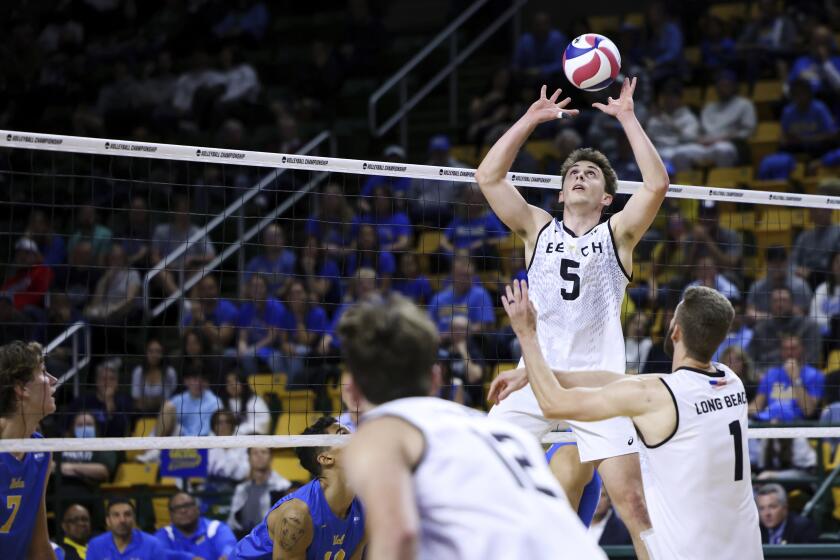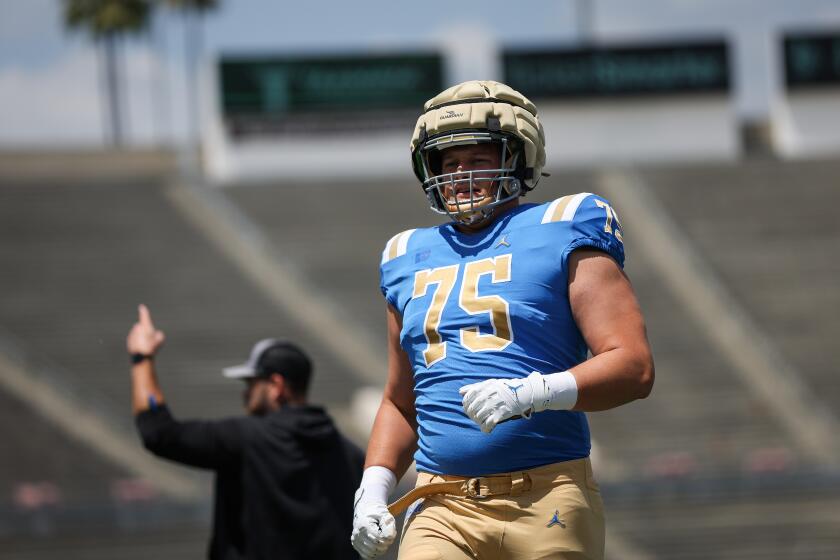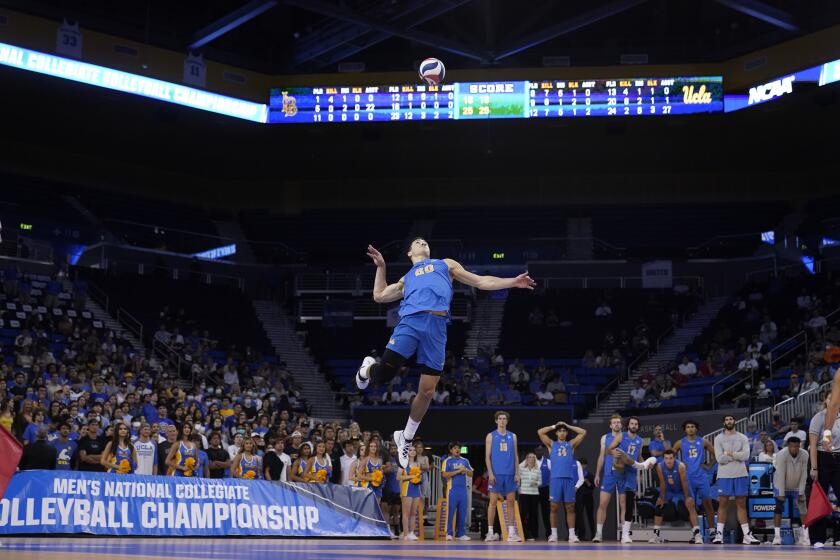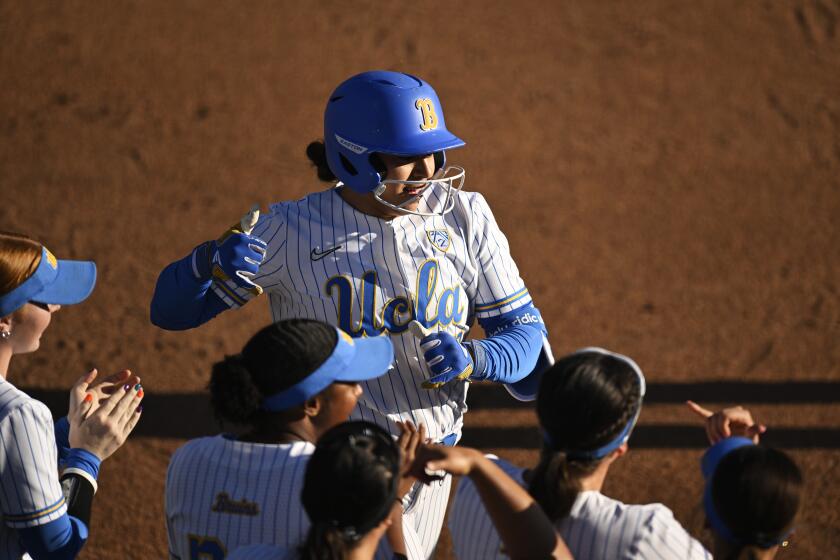Bracket theories
The idea of a UCLA-Florida rematch in the NCAA championship game is officially kaput.
Even if they both make it to the Final Four in Atlanta, the Bruins and Gators would meet in a national semifinal instead.
It won’t be easy getting there, but it never is.
UCLA is fighting a late-season mini-slump after its loss in the Pacific 10 tournament quarterfinals cost the Bruins a No. 1 seeding in a year when the NCAA selection committee went gaga for Championship Week.
UCLA’s No. 2 seeding behind Kansas in the West comes with a soft landing, though: The Bruins wouldn’t have to leave California the first two weeks to reach the Final Four.
Florida, seeded No. 1 overall, has to do battle with history.
No team has repeated as NCAA champion since Duke in 1991 and ‘92, and before that you have to go all the way back to the heyday of the UCLA dynasty.
“We know what we’re capable of doing,” Florida’s Joakim Noah said as the cameras surrounded him on the court while the Gators celebrated their Southeastern Conference tournament victory, shaking off three late-season losses by roaring through the SEC tournament, winning by an average of almost 20 points a game.
“There are a lot of doubters out there,” Noah said. “Ws and rings are all that matter to us.”
The announcement of the 65-team field for the NCAA tournament set off the usual debates Sunday, but it was a notable day for Southern California.
Three seasons after the Los Angeles area didn’t have a single team in the NCAA tournament, there are three: USC, which earned a No. 5 seeding in the East, and Long Beach State, seeded No. 12 in the South after winning the Big West Conference title, joined UCLA.
The Pac-10 is sending six teams, tying the league record set in 2002, after Stanford sneaked in as a No. 11 in the South, one of the last at-large teams in the field.
It was a year when conference tournaments seemed to reign supreme for the selection committee.
The four teams that received No. 1 seedings -- Florida (29-5), North Carolina (28-6), Ohio State (30-3) and Kansas (30-4) -- won their conference tournaments.
The contenders who fell by the wayside didn’t.
UCLA (26-5), ranked No. 1 for six weeks during the season and No. 1 in the final regular-season Rating Percentage Index, was one.
So was Wisconsin (29-5), which lost to Ohio State in a Big Ten final that turned into a play-in game for a No. 1 seeding.
The lateness of some of Sunday’s title games put a squeeze on the committee, forcing them to make plans based on “contingencies,” said Gary Walters, the Princeton athletic director and chairman of the 10-person group.
The overtime Big 12 title game between Kansas and Texas -- featuring a riveting performance by Kevin Durant, the wunderkind freshman -- didn’t end until 20 minutes before the televised announcement of the bracket on CBS, and Walters acknowledged the committee named Kansas a No. 1 before it won.
The difference between a No. 1 and a No. 2 can be esoteric, other than travel considerations.
What really matters is whether you’re in, and this was an unusually tough field to crack
“We actually had 104 teams that had won 20 or more games, and that was more than the previous record of 78,” Walters said.
To solve that issue of “compression and congestion,” the committee emphasized conference tournaments.
Consider the effect of those tournaments on the fates of Arkansas and Syracuse.
Arkansas, a team that was 18-12 and 7-9 in the SEC before its four-game run to a conference title game it lost to Florida by 21 points, is in the field.
Syracuse, a team that was 22-9 and 10-6 in the Big East before a quarterfinal loss in the conference tourney, is not.
Arkansas’ best wins were over Southern Illinois and a sweep of Vanderbilt.
Syracuse’s best wins were over Georgetown, Villanova and on the road against Marquette -- although the Orange lost at home to Drexel, another bubble team that didn’t make it.
You might see images of Syracuse Coach Jim Boeheim on the court during this NCAA tournament anyway, but it will be in clips of Carmelo Anthony leading the Orange to the 2003 title as a freshman before turning pro, a rare one-and-done feat Durant would like to repeat.
Ohio State freshman Greg Oden has the same type of opportunity.
But Boeheim cautioned that he believes it will remain rare, even with more top-level pro prospects stopping off in college for a season because of the new NBA minimum age.
“It’s exceptionally unusual,” Boeheim said.
“I think a freshman can help win it, but I think you need others for it to be possible.”
A No. 3-seeded team that season, Syracuse went on a run that culminated in Anthony’s 33-point performance against Texas in the semifinals, and his 20-point, 10-rebound game against Kansas in the title game.
Ohio State starts two freshmen -- Oden and point guard Mike Conley Jr. -- two seniors and a junior.
Texas, a No. 4-seeded team headed for a potential second-round clash of athleticism with USC, starts four freshmen and a sophomore.
Durant has made it clear the title is on his mind.
“Oh yeah, it is the bigger picture. It is a bigger week next week,” he said.
Looking at the bracket, the “bigger” teams fared surprisingly well.
Sure, there were major-conference teams that didn’t make it: Florida State, which had beaten Florida. West Virginia, whose win over a UCLA team that didn’t have Darren Collison didn’t count for much. Kansas State.
But a year after George Mason made its Cinderella run to the Final Four as a No. 11-seeded at-large team, only six mid-majors received at-large berths, the fewest in recent years.
Drexel (23-8) became the poster team for snubbed mid-majors. The Dragons won at Villanova, at Syracuse and at Creighton -- but lost in the semifinals of the Colonial Athletic Assn. tournament.
The resumes of 20-win teams probably littered the floor of the committee workroom.
Air Force, ranked in the top 25 much of the season, cost itself a bid by losing its last four games. Missouri State didn’t make it either.
Nor did Appalachian State, the school that placed a $10,000 ad in the Indianapolis Star to try to sway the NCAA basketball committee, or at least drum up enough publicity to be on the pundits’ tongues.
“I think they were a little disappointed, but they understand that the teams that are in are very deserving,” said Appalachian State Athletic Director Charlie Cobb, who came up with the idea of the ad. “There’s no outrage or anything like that. We’re sitting around now waiting to hear about the NIT.”
In the parlance of March Madness, that stands for Not In Tournament
Florida, suddenly the favorite again, will try to win it with five starters who all came back, some of them passing up millions.
The Gators have had their struggles this season.
“I think there is a big difference between this year and last year. Like last year, there were no expectations,” Noah told reporters after the SEC title game.
“I realize that I’m playing for the people I love, and I’m playing for my teammates and my family. I’m not playing for what people say on TV. And everybody has something to say. You know, that drains you. That wasn’t there last year.”
Those struggles, though, might have helped the Gators address problems such as a defense that had suddenly gone south.
When Nevada Las Vegas tried to repeat after winning the 1990 NCAA title, the Rebels “never had a close game,” Jerry Tarkanian has lamented, and Duke ended the Rebels’ undefeated season in a Final Four semifinal.
Noah gets the idea.
“I think what’s important this time of year, is to realize if you don’t play hard, and you don’t win, you’re going home,” he said.
Go beyond the scoreboard
Get the latest on L.A.'s teams in the daily Sports Report newsletter.
You may occasionally receive promotional content from the Los Angeles Times.



